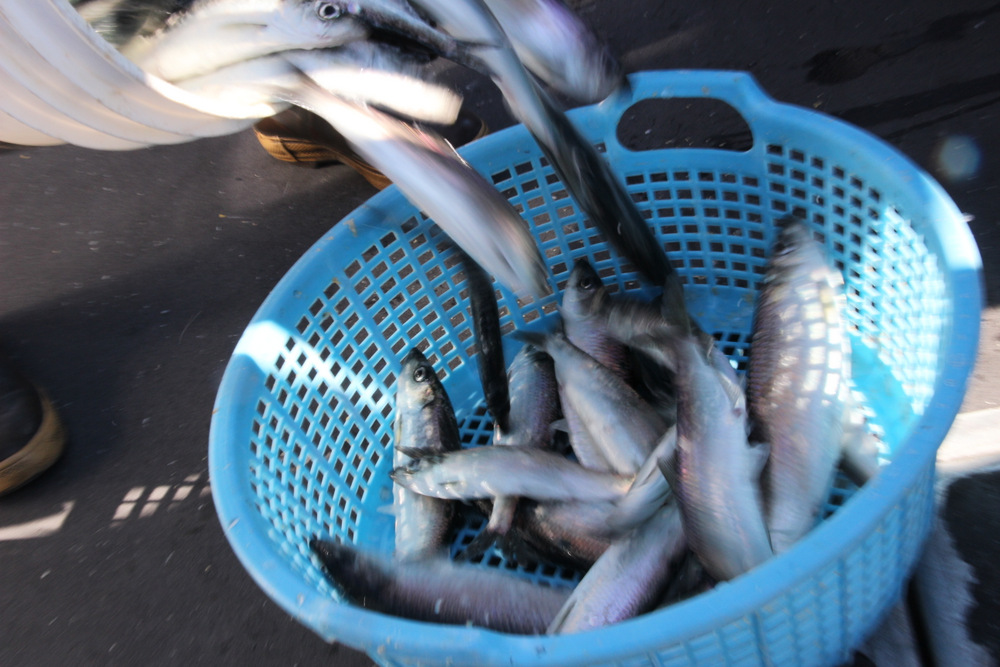
Herring caught during the 2014 Sitka Sound sac roe fishery. A recent study suggests that managers could take a longer view when directing fisheries like this one. (KCAW photo/Rachel Waldholz)
A recent study suggests that current herring populations in Southeast Alaska and British Columbia may be just a remnant of what once existed.
Archaeologist Madonna Moss has studied sites in and around Southeast Alaska for decades. She says that evidence gathered by researchers up and down the coast indicates that herring were once far more widespread –and far more abundant – than they are today.
And, she says, fishery managers should look to the past when making decisions about the present.
Moss is part of a team of scientists who pulled together data from 171 archaeological sites stretching from Yakutat to Puget Sound. They identified nearly half a million different fish bones from the sites, some of which are nearly 10,000 years old.
And what they found was a lot of herring. The team found herring bones in all but two of the sites, and, Moss said, “Herring bones were the most numerous bones in most of the sites. And that was a surprise, because on the northwest coast, if you ask what fish is the most important, people will, of course they’ll say salmon.”
The team found herring bones everywhere: in places where you find large populations of herring today and, more tantalizingly, in lots of places where you won’t find herring today, but where oral histories or place-names imply herring were once present.
“And that is a significant finding, in that it helps illustrate how the spatial distribution of herring has contracted into fewer localities, whereas in the past, herring bones were really widespread in archaeological sites,” Moss said. “So there’s been a spatial constriction of where herring are abundant.”
In all, nearly half of the fish bones collected from the sites were from herring. The team concluded that the only way you’d see that number of herring bones, in that many sites, is if herring populations in the past were far larger, and far more widespread, than they are now.
And that, they argue, should influence how the populations are managed today.
That hypothesis isn’t accepted by many fishery managers. But it aligns with what many in the Sitka Tribe have said for a long time.
“I think that the archaeological work in this case really does support the life experience of people who have been fishing herring and watching herring and collecting eggs for a very long time,” Moss said.
The paper was published in February, in the Proceedings of the National Academy of Sciences. The lead author is Iain McKechnie, of the University of British Columbia. It’s a follow-up to a major project by Moss and other researchers, first published in 2010, that pulled together archaeological data, oral histories, and biological and historical records to try to piece together a map of where herring were known to spawn in Southeast Alaska before the advent of industrial fishing. This most recent paper was in part an attempt to extend that map down the coast, focusing in particular on British Columbia.
Moss says that while many factors influence herring populations — including pollution, climate change, and the rebounding populations of predators like whales and sea lions — she personally thinks that industrial fishing in the late 19th and early 20th centuries had a much more severe impact than modern managers assume.
“I think that huge numbers of herring were taken out of the system years ago,” Moss said. “And then there was kind of a lull, and the fisheries recovered, and then the 1970s becomes kind of the baseline that many fishery scientists rely on. And so if you compare the herring numbers to the 1970s, they might not look so bad. But if you go back 150 years, they look pretty paltry.”
Madonna Moss will deliver a lecture on the archaeology of herring tonight (Fri 4-4-14), as part of the Sitka Herring Festival Community Potluck. The potluck will run from 6-9 PM, in Harrigan Centennial Hall.






























